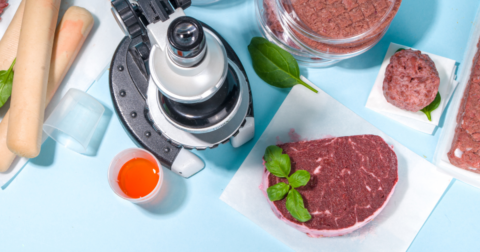News
Costco Chicken Processing Plant Keeps Failing Tests for Salmonella
Food•5 min read
Reported
A new Dutch public-private partnership brings together cultivated meat companies with farmers.


Words by Francesco deAugustinis
The lab grown meat industry seems to be floundering, at least if you go by the news coverage. Even as Good Meat and Upside Foods earned regulatory approval in the U.S. to sell to the public, stories in Bloomberg, Wired and The Wall Street Journal showed an industry struggling to find financial footing and make enough meat to sell at scale. But in the Netherlands, the future of cultivated meat looks a little different, a true mashup of technology and locally grown food. There, a new partnership has companies working in tandem with farmers, to build bioreactors in barns rather than factories, and with government funding.
Cultivated meat, sometimes called cell-cultivated, cultured or lab-grown meat, is “real” meat made from cells taken from an animal rather than raising and slaughtering an entire cow or chicken. The process is expensive and challenging to scale, requiring manufacturers to feed a costly growth serum to starter cells, the “feedstock” that gets the cells to grow.
Nearly a year ago, Ira van Eeelen, the daughter of the Dutch scientist who is widely considered the godfather of the cultured meat industry, began researching the idea of a “decentralized” cultured meat production system, where small cultivated meat producers partner with, and even locate their processing facilities, on Dutch farms. The research was financed by the European Union and a consortium of private companies, including Dutch cultivated meat company Mosa Meat, for an investment of just under $1 million. The team is trying to determine whether such a production model is feasible and sustainable, “by designing a cultivated meat farm and a digital prototype” to be completed by the middle of 2024.
Van Eelen says the idea of working with farmers to develop cultivated meat may sound new, but it actually dates back to the beginning of this technology. “What most people don’t know is that the origin of the idea of cultivated meat was actually for farmers,” van Eelen tells Sentient Media, “with farmers and to be done by farmers.” Farmers were always intended to be part of the production process, and at every stage. “It was invented with farms in mind,” she says. It starts with animal farmers: “they have the animals to get cells from,” she says, but includes crop growers, who harvest what’s fed to the cells too.
Van Eelen is the co-founder of Respectfarms, a Dutch cultivated meat startup that aims to center farmers in its production of cell-cultivated meat. She spoke with Sentient Media at Mosa Meat headquarters in Maastricht, a city in the Netherlands.
“When I came back to the world of cultivated meat in 2017, I saw that there was a huge emphasis on doing this in large scale facilities like factories,” she tells Sentient Media. Farmers were no longer playing much of a role, and van Eelen wanted to see a course correction. “The original research showed that farmers could actually be part of cultivated meat, by producing that in their barns and by also providing the materials that you need to feed the cells. Because, like animals, cells also need to be fed.
Van Eelen’s vision is a meeting of technological achievement with agrarian tradition. The way cultivated meat is made, stem cells are fed glucose, which is extracted from crops, plus amino acids and proteins. The crops, which could be barley, maize, potato or wheat, are grown on farms, and then ultimately fed to the cells in bioreactors housed in barns right on the farm, to eventually become a burger, nugget or steak.
At the moment, the idea is just in its infancy. “In the Netherlands right now [we’re] trying to validate a business model,” says van Eelen, a business model built on the tech-farmer partnership. “Currently we are working to …build a first farm in the Netherlands and take it from there to build more farms,” she says. Her hope is these farms will some day be “not only in the Netherlands, but also in Spain, Italy, Africa, Indonesia [and] the United States.”
Respectfarms has produced a short film, a kind of commercial for the work they want to carry out on a Dutch pilot farm, a 70-acre family operation owned by Leon Moonen, a farmer who raises free range cattle in a reserve located in the Eindhoven region of the Netherlands.
“Since 1989 we breed our cows in a forest, like you see in the film,” Moonen tells Sentient Media at Mosa Meat headquarters. The cattle farmer says it was a new vision for his own future that won him over. “In 2011, I was doing my studies and I had to think about what I’ve got with my product in about 30 years. And it was not to slaughter them, the cows. That was suffering.”
For Moonen, the idea that he could still produce meat without slaughter is incredibly compelling. “It would be nice that you can breed cows, sometimes collect biopsy from a cow, and produce with that biopsy a lot of meat to feed the people,” he says.
Yet when Moonen first decided to join the Respectfarms project, the response from other Dutch farmers was hostile, he says. So hostile, in fact, that’s not him in the video linked above. It’s an actor playing the farmer, who is identified by another name. In the Netherlands and beyond, many farm industry groups are opposed to cultured meat and, in some countries, including the U.S., there are legal campaigns to ban cultivated meat or at least restrict how it can be sold.
Alessandro Apolito, a representative from the Italian farmers association Coldiretti, supports strict legal restrictions. “Cultured meat should be subjected to the authorization process for drugs, not for food,” he tells Sentient Media by phone. Coldiretti led the campaign to persuade the Italian government to restrict development of what it defines as “synthetic meat.” What groups like Coldiretti fear is that cultivated meat technology will end up concentrating even more of meat production in the hands of a few large companies. The campaign in Italy was a success — the government recently passed a ban in the country, not just on selling cultivated meat, but also even to produce it.
Yet, at least according to Moonen, in the last few years sentiment in the Netherlands has been changing, in part perhaps due to outreach efforts from Respectfarms. “When I speak to other farmers at this moment,” he says, they’re welcome. “They say, ‘when you need something from me, you can make a phone call’.”
More farmers are becoming interested in producing meat with a lower environmental impact, especially excessive nitrogen pollution, which is a problem in the Netherlands. But according to Moonen, the case for animal suffering also resonates, especially with young farmers: “You don’t have to slaughter the cows,” he says. “And all the arable land I have, I can use it also to feed the cells. Maybe I’ll have fewer animals, but I can have a lot of acres to produce.”
One of the largest obstacles facing cultivated meat is cost. To date, the price of cell-based meat products in the United States is around $17 per pound. “The costs of the ingredients and facilities are enormously high,” says Rene Wijffels, researcher at Wageningen University & Research (WUR), also known as the Dutch “food Silicon Valley.”
What might help — more government investment and open access research. Wijffels’ work on cultured meat is publicly funded, but that’s a rarity in the field. He’s working with Maastricht University and WUR to create a public sector alternative.
Wijffels’s research is aimed at developing alternative feedstock — seaweeds, plants and microorganisms. The outcome of this research could determine not only the success of cultured meat on the market, but also give researchers a clearer understanding of the environmental impacts.
The precise climate impact of cultivated meat is another challenge. Studies conducted by the non profit think tank Good Food Institute suggest that cultivated meat could have a smaller carbon footprint than beef and, with clean energy, other types of meat too. Yet a 2023 study from U.C. Davis claimed the opposite, that lab-grown meat’s carbon footprint could be even worse than farmed beef. That study was criticized, but not before it received lots of media attention, which happened prior to final publication — in other words, before the study was subject to peer review.
Ultimately, researchers disagree about a few key details, including the amount and kind of energy required to produce cultivated meat. Using clean energy to power the bioreactors, if available, would make a huge difference, but that requires decarbonizing the energy grid, and that’s not a given.
Still, environmental scientists do agree on this: the amount of conventional meat the world produces is unstainable, and a wide range of alternatives are needed. “The projection is that global meat consumption might have to double in the next decades, which is a big problem. We have to do something,” says van der Goot.
The most efficient solution would simply be to eat less meat and more vegetable products, argues Atze Jan van der Goot, another WUR researcher who has been working on the production of plant based meat for 25 years. But advocates for healthier diets have been arguing for more lentils and beans for years, and finding little success.
Ira van Eelen sees cultured meat as one of many solutions. “In an ideal world, we would be able to do cultivated meat tomorrow, and do away with [slaughtering] animals,” she says. “But in the realistic world, right now, the best that we can hope for is that it becomes a complementary protein source.”
“Why do we need meat alternatives?” asks van der Goot. “To help consumers change.” These substitutes can help people make the kinds of dietary changes climate scientists recommend. “This is why we try to make it identical,” he says, “to make the change easier for consumers.”